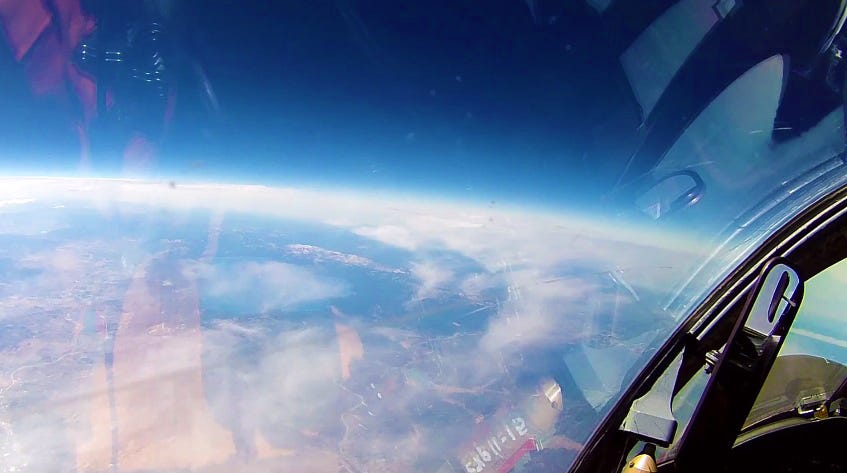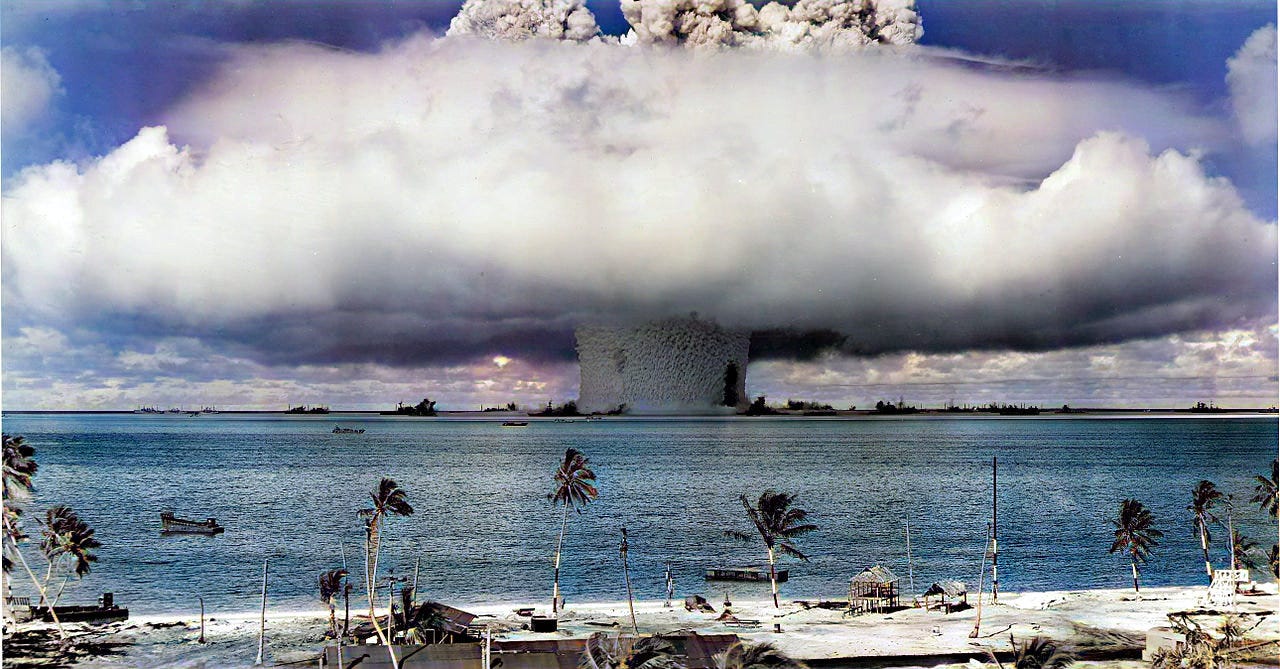He was in the air for more than eight hours. He was tired, trapped within a heavy helmet and an uncomfortable pressure suit that resembled an airtight cocoon. The air was so thin that he would be dead in seconds without a space suit. He was flying at 65,000 feet (about 19,800 metres). 95 per cent of the atmosphere was below him.
He could see across whole countries, but he was alone in complete radio silence. His food was a liquidized paste, which was inserted into the helmet through a tube on a special port. The date was 5 July 1956, and the CIA pilot Hervey Stockman (1922-2011), was flying the first reconnaissance mission of the Lockheed U-2 over the Soviet Union.

The Lockheed U-2, nicknamed “Dragon Lady”, is an agile, single-engine, and high-altitude aircraft designed for intelligence gathering, surveillance and reconnaissance missions. It was built in the 1950s in complete secrecy. It could operate at 70,000 feet (about 21,000 metres) higher and for longer periods than any other aircraft since then. However, its unique design, with its long, narrow winds and high aspect ratio, made it challenging to handle, particularly during take-off and landing. Also, at an altitude close to the limit, only 6 knots separated the speeds at which low-speed stall and high-speed buffet occurred. If the aircraft slowed beyond the low-speed stall limit, it could lose lift and begin to fall. Pilots have a name for this narrow range of acceptable airspeeds; they call it ‘coffin corner.’
As a reconnaissance aircraft, the primary role of U-2 was to gather information during the Cold War era. But its high-altitude capabilities have also made it valuable for scientific research. The aircraft was equipped with large-format cameras, finer than any other plane before. They were designed by Edwin Land, a flamboyant genius and Harvard dropout who invented the Polaroid.
The U-2 was not just equipped to see. It could sniff as well. It was equipped with instruments to detect and sample aerosols of the upper air and also to bring down samples for further study. Between 1945 and 1960, the United States and the USSR tested hundreds of nuclear weapons. These were the most disturbing experiments ever conducted by scientists in relation to military programs. The U-2 pilots, guided by their Geiger counters, could collect samples of the bomb’s radioactive fallout before it fell. This provided scientists with insights into both the weapons being tested and the circulation of the stratosphere.

America’s Atomic Energy Committee (AEC), responsible for making and testing the bombs, held that the risks to human health from nuclear fallout were very small. They thought that the fallout, for the most part, was mostly in the lower stratosphere (10 kilometres or around 6.2 miles above the ground in the middle latitudes) and it stayed there for only a couple of years. Dr Willard Libby, an AEC appointee who worked on the Manhattan Project, disagreed. Libby argued that radioactive fallout is “unlike any other. Time and distance are no longer compact and predictable,” he said. “Fall out lingers, travels with the wind and may persist for long periods of time.”
Today, we know that in the zones where jet streams occur, 9-16 kilometres above the surface of the Earth, air circulation is uneven and mixes more freely than it does elsewhere. As the British science writer Oliver Morton puts it … “This means that fallout not only came down from the lower atmosphere quicker than Libby and the AEC thought; it also did so preferentially in particular parts of North America, Europe, Russia and China - that is, in the belt of land above which the northern jet stream winds its way.”

Radioactive fallout and spread were not only of interest to atmospheric scientists who had already begun to study the troposphere's behaviour. It also mattered to anti-nuclear campaigners. Indeed, the first truly global environmental issue that engendered widespread protests and political debates was the danger of the fallout from nuclear testing.
As U-2 was well-suited for atmospheric research, it also allowed previously invisible processes, such as atmospheric chemistry, weather patterns, and other environmental factors to be studied. Roger Revelle, an oceanographer and director of the Scripps Institution of Oceanography in La Jolla, California, who had been studying the increase of atmospheric carbon dioxide, used it to look into the exchange of carbon dioxide between the atmosphere and the oceans.
Data sharing between aircraft and ground control, as well as the improvement of efficiency and effectiveness of intelligence gathering, was crucial and, therefore, the U-2 has also contributed to the development of satellite technology by pioneering the use of data links to relay intelligence to ground stations thousands of miles away, bouncing the signals off satellites.
Early on, scientists realised that satellites could be used for other purposes, apart from providing intelligence information on foreign countries' military activities. One of the first scientists to realise the potential of satellites for Earth observation and data collection from the upper atmosphere was the Austrian-born American physicist Siegfried Fred Singer, director of the Centre for Atmospheric and Space Physics, University of Maryland and later Special advisor to President Eisenhower on Space Development. In 1951, Singer proposed the MOUSE ("Minimal Orbital Unmanned Satellite, Earth"), a 100-pound satellite that would contain Geiger counters for measuring cosmic rays, photo cells for scanning the earth, telemetry electronics for sending data back to earth, a magnetic data storage device and rudimentary solar energy cells. He was one of the first scientists to advocate Earth satellite launches for scientific observation, paving the way for future satellite technology development. He was so confident that satellite technology would be the future in the observation of weather and climate phenomena, that in 1958 he said, that the application of meteorological satellites would “affect our way of life more than any other aspect of this space flight business, except possibly for man to travel to the planets”.
The message for Moscow was similar. The newspaper Pravda, the official organ of the Communist Party of the Soviet Union, ran a story by Dr A.N. Nesmayanov, the president of the USSR Academy of Sciences, which boasted: “The creation and launching of the Soviet artificial satellite purposes during the International Geophysical Year [1957] will play an exceptional role in unifying the efforts of scientists of various countries in the struggle to conquer the forces of nature.”
The signals from the East did not go unnoticed by the United States. The country was in the throes of a looming political crisis caused by the Supreme Court's 1954 decision on Brown v. Board of Education. The decision legally ended decades of racial segregation in public schools. (Brown v. Board of Education, n.d.) The crisis quickly escalated into a major challenge to President Eisenhower’s authority, particularly in the South, where segregation was deeply entrenched. Nineteen senators and seventy-seven congressional representatives issued a defiant proclamation, called the “Southern Manifesto”, in March 1956, condemning the Supreme Court decision as an abuse of judicial power that trespassed upon states' rights and urged southerners to exhaust all “lawful means” to resist the “chaos and confusion” that would result from school desegregation. Only Albert Gore Sr. of Tennessee and Lyndon Baines Johnson, the majority leader of Texas, refused to sign the document.
In October 1957, the Soviets launched the world’s first artificial satellite, Sputnik I, setting off alarm bells in the Eisenhower administration and creating intense fear and anxiety among the US public that the Soviet Union had surpassed the technological achievements of the United States. Then everything changed.
Sources and further reading
Brown v. Board of Education. (n.d.). Retrieved from National Archives : https://www.archives.gov/education/lessons/brown-v-board
Bulletin of the Atomic Scientists. November 1956, V. X. (1956, November). Bulletin of the Atomic Scientists. Vol. XII (9).
Janice, H. (1991). The weather from above: America's Meteorological Satellites. Smithsonian Institution Press.
Krieger, F. (1958). Behind the Sputniks—A Survey of soviet space science. Washington, D.C.,: Public Affairs Press,.
Oliver Morton, (. 3.-4. (2015). “The Planet Remade : How Geoengineering Could Change the World”. Princeton University Press.
Pedlow, G. a. (1998). CIA And The U-2 Program, 1954-1974.
Piesing, M. (2020). The veteran spy plane too valuable to replace. Retrieved April 29, 2023, from BBC Future: https://www.bbc.com/future/article/20201210-lockheed-u-2-spyplane
Project Apollo: A Retrospective Analysis. (n.d.). Retrieved from NASA History: https://history.nasa.gov/Apollomon/Apollo.html
The Southern Manifesto of 1956. (n.d.). Retrieved from History, Art and Archives, US House of Representatives : https://history.house.gov/Historical-Highlights/1951-2000/The-Southern-Manifesto-of-1956/



